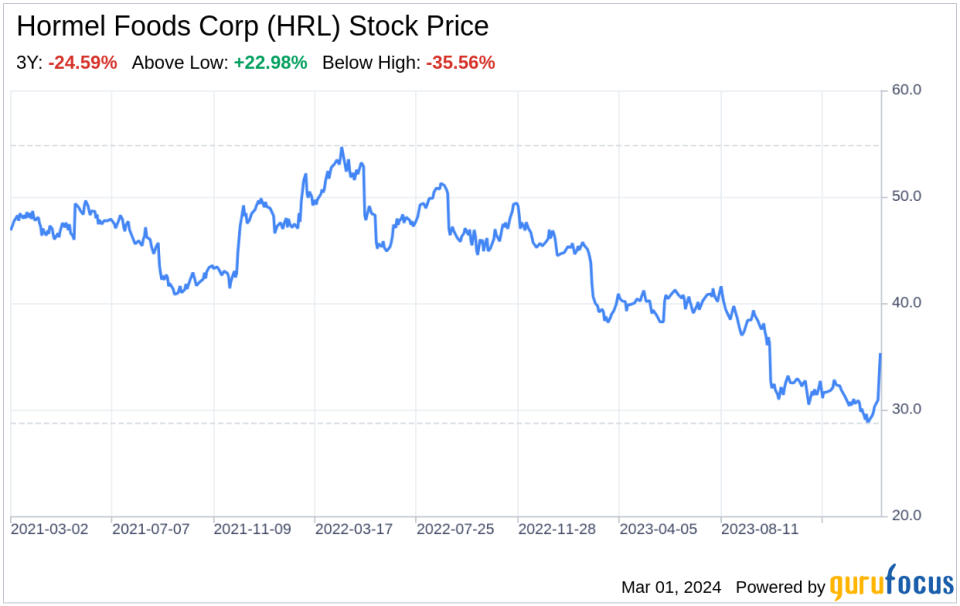Decoding Hormel Foods Corp (HRL): A Strategic SWOT Insight
Robust brand portfolio with market leadership in various categories.
Strategic investments in international markets and modernization initiatives.
Challenges in commodity pricing and competitive retail landscape.
Opportunities for growth in foodservice and international segments.
On February 29, 2024, Hormel Foods Corp (NYSE:HRL) filed its 10-Q report, revealing a nuanced financial landscape. The company, known for its diverse protein-based product offerings, reported a marginal increase in net sales from $2.97 million thousand to $3.00 million thousand year-over-year. Despite a competitive market, Hormel Foods Corp maintained its gross profit, which saw a slight rise from $495,949 thousand to $508,733 thousand. The operating income, however, experienced a slight dip from $289,452 thousand to $284,438 thousand. These figures underscore the company's resilience in navigating market fluctuations and maintaining profitability.

Strengths
Brand Power and Market Share: Hormel Foods Corp (NYSE:HRL) boasts a strong brand portfolio, including Hormel, Spam, Jennie-O, and Skippy, many of which hold the number one or two market share in their respective categories. This brand power is a testament to the company's robust marketing strategies and consumer loyalty. For instance, the company's net sales increase in the first quarter of fiscal 2024 was driven by higher volumes in each segment, showcasing the strength of its brand portfolio in driving growth.
Financial Stability: Hormel Foods Corp's financial stability is evident in its consistent net earnings, with a slight increase from $217,719 thousand to $218,863 thousand year-over-year. The company's basic and diluted net earnings per share remained steady at $0.40, reflecting a stable financial position. This stability is crucial for sustaining operations and pursuing growth opportunities.
Diversified Product Portfolio: The company's diversified product range, spanning perishable food, shelf-stable products, poultry, and other items, allows it to cater to various consumer needs and preferences. This diversification helps mitigate risks associated with market volatility and consumer trends, as evidenced by the company's ability to maintain a steady gross profit margin.
Weaknesses
Commodity Price Sensitivity: Hormel Foods Corp's operations are subject to fluctuations in commodity prices, particularly for pork, beef, and feed. These volatile input costs can impact the cost of products sold, which increased from $2.48 million thousand to $2.49 million thousand in the reported quarter. The company's reliance on these commodities makes it vulnerable to price swings that can affect profitability.
Increased Operating Expenses: The company's selling, general, and administrative expenses rose from $222,056 thousand to $240,386 thousand, indicating increased costs in managing its operations. These higher expenses can erode profit margins and necessitate a focus on cost management and efficiency improvements.
International Market Challenges: While Hormel Foods Corp has a presence in international markets, it faces challenges such as lower branded export demand and sales in China, as mentioned in the filing. These challenges highlight the need for strategic market analysis and adaptation to local consumer behaviors and economic conditions.
Opportunities
Foodservice Segment Growth: Hormel Foods Corp has witnessed strong growth in its Foodservice segment, led by products like Hormel Bacon 1 precooked bacon and premium prepared proteins. The company's ability to capitalize on this segment's potential can drive future revenue growth, as indicated by the segment's performance in the first quarter of fiscal 2024.
International Expansion: The company's strategic investments in international markets, such as the inclusion of its investment in Indonesia and partnership in the Philippines, present opportunities for global expansion and diversification of revenue streams. These investments can help Hormel Foods Corp tap into new consumer markets and reduce dependence on domestic sales.
Modernization Initiatives: Hormel Foods Corp's transformation and modernization initiative, aimed at delivering cost savings and improving efficiency, positions the company to enhance its competitive edge. By focusing on packaging, logistics, and production costs, Hormel Foods Corp can improve its operational efficiency and profitability.
Threats
Competitive Retail Landscape: The retail segment is highly competitive, with numerous players vying for market share. Hormel Foods Corp faces the challenge of maintaining its position amidst aggressive pricing strategies and promotional activities by competitors. This competitive pressure can impact the company's sales and profitability, as seen in the decline of segment profit in the retail sector.
Economic Uncertainties: Macroeconomic factors, such as inflation and changing consumer spending patterns, pose threats to Hormel Foods Corp's financial performance. Economic uncertainties can lead to cost increases and affect consumer demand for the company's products, as evidenced by the sensitivity to commodity pricing.
Regulatory and Health Concerns: Hormel Foods Corp operates in an industry subject to stringent regulations and health concerns. Issues like Highly Pathogenic Avian Influenza can disrupt supply chains and affect product availability, as mentioned in the company's cash flow analysis. These concerns require diligent risk management and contingency planning.
In conclusion, Hormel Foods Corp (NYSE:HRL) exhibits a strong market presence with its diverse and leading brand portfolio, financial stability, and strategic international investments. However, the company must navigate weaknesses such as commodity price sensitivity and increased operating expenses, while seizing opportunities in the foodservice segment and international expansion. The threats posed by a competitive retail landscape, economic uncertainties, and regulatory concerns require vigilant management and strategic planning.
This article, generated by GuruFocus, is designed to provide general insights and is not tailored financial advice. Our commentary is rooted in historical data and analyst projections, utilizing an impartial methodology, and is not intended to serve as specific investment guidance. It does not formulate a recommendation to purchase or divest any stock and does not consider individual investment objectives or financial circumstances. Our objective is to deliver long-term, fundamental data-driven analysis. Be aware that our analysis might not incorporate the most recent, price-sensitive company announcements or qualitative information. GuruFocus holds no position in the stocks mentioned herein.
This article first appeared on GuruFocus.
